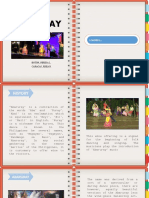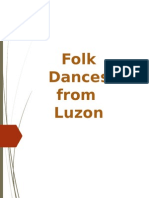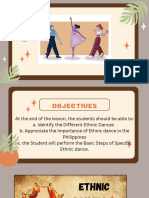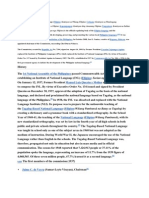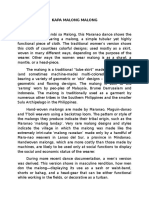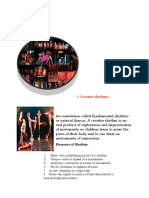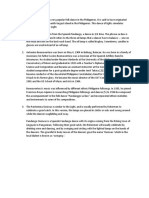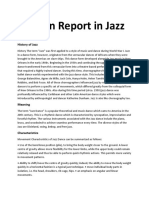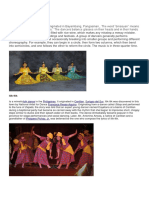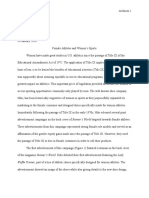0 ratings0% found this document useful (0 votes)
3K viewsCariñosa
Cariñosa
Uploaded by
Joseph Eric NardoThe Cariñosa is a Philippine folk dance of Hispanic origin that originated in the Panay Islands. It is related to Spanish dances like the bolero. Dancers traditionally wore Spanish-influenced costumes like the Maria Clara dress. The music has a distinct 3/4 rhythm showing Spanish musical influences. There are some regional variations, like in Bicol where dancers use handkerchiefs in their footwork instead of fans.
Copyright:
© All Rights Reserved
Available Formats
Download as DOCX, PDF, TXT or read online from Scribd
Cariñosa
Cariñosa
Uploaded by
Joseph Eric Nardo0 ratings0% found this document useful (0 votes)
3K views12 pagesThe Cariñosa is a Philippine folk dance of Hispanic origin that originated in the Panay Islands. It is related to Spanish dances like the bolero. Dancers traditionally wore Spanish-influenced costumes like the Maria Clara dress. The music has a distinct 3/4 rhythm showing Spanish musical influences. There are some regional variations, like in Bicol where dancers use handkerchiefs in their footwork instead of fans.
Original Description:
Philippine Folk dances
Copyright
© © All Rights Reserved
Available Formats
DOCX, PDF, TXT or read online from Scribd
Share this document
Did you find this document useful?
Is this content inappropriate?
The Cariñosa is a Philippine folk dance of Hispanic origin that originated in the Panay Islands. It is related to Spanish dances like the bolero. Dancers traditionally wore Spanish-influenced costumes like the Maria Clara dress. The music has a distinct 3/4 rhythm showing Spanish musical influences. There are some regional variations, like in Bicol where dancers use handkerchiefs in their footwork instead of fans.
Copyright:
© All Rights Reserved
Available Formats
Download as DOCX, PDF, TXT or read online from Scribd
Download as docx, pdf, or txt
0 ratings0% found this document useful (0 votes)
3K views12 pagesCariñosa
Cariñosa
Uploaded by
Joseph Eric NardoThe Cariñosa is a Philippine folk dance of Hispanic origin that originated in the Panay Islands. It is related to Spanish dances like the bolero. Dancers traditionally wore Spanish-influenced costumes like the Maria Clara dress. The music has a distinct 3/4 rhythm showing Spanish musical influences. There are some regional variations, like in Bicol where dancers use handkerchiefs in their footwork instead of fans.
Copyright:
© All Rights Reserved
Available Formats
Download as DOCX, PDF, TXT or read online from Scribd
Download as docx, pdf, or txt
You are on page 1of 12
Cariosa
From Wikipedia, the free encyclopedia
Cariosa (Spanish pronunciation: [kaiosa], meaning the loving or affectionate one) is a Philippine dance
of Hispanic origin from the Maria Clara suite of Philippine folk dances, where the fan orhandkerchief plays an
instrumental role as it places the couple in romance scenario.
Contents
[hide]
1 History and Emergence as a national folk dance
2 Bicolano Cariosa
3 Costume of Carinosa
4 Music
5 See also
[edit]History and Emergence as a national folk dance
The dance was originated in the Panay Islands on the Visayan Islands and it was introduced by
the Spaniards during their colonization of the Philippines. It is related to some of the Spanishdances like
the bolero and the Mexican dance Jarabe Tapatio or the Mexican Hat Dance.
[edit]Bicolano Cariosa
According to the book of Francisca Reyes-Aquino, Philippine Folk Dances, Volume 2, there is a different
version of the dance in the region of Bicol. In the Bicol Region Carinosa, hide and seek movement is different.
In the original version, the dancers used the Fan and handkerchief as the way to do the hide and seek
movement, in Bicol they used two handkerchiefs holding the two corners of the handkerchief and doing the
hide and seek movement as they point their foot forward and their hands go upward together with their
handkerchiefs following the movement. It is a complicated step however it is still used in Bicol Region region
during festivals and social gatherings.
[edit]Costume of Carinosa
Originally Carinosa was danced with Maria Clara dress and Barong Tagalog for it is a Maria Clara Spanish
Dance when it is introduced. However as the Filipino people saw and imitated this dance, they wore the
patadyong kimona and camisa de chino to reveal their love as a Filipino and other steps was revised to make it
more Filipino but the music did not change at all and reveals aSpanish Influence to the Filipinos. As listed by
the book of F.R. Aquino dancers may wear balintawak style (a native dress of the Tagalog regions), camisa (a
white sleeve) or patadyong kimona ( a dress of the Visayan of people)and for boys a barong Tagalog and
colored pants. Because it is a national dance, the dancers may wear any Filipino costumes.
[edit]Music
The music of Carinosa shows a great Spanish influence to the Filipinos. It is 3/4 in rhythm like some of
the Spanish dances. The Philippine Rondalla are playing this music of the dance where it is an ensemble or
an orchestra of string instruments in the Philippines similar to the Spanish musicians in Spain that
comprises bandurrias, mandolins, guitar, basses, drums, and banjos. Mostly men are playing rondalla
instruments but women may also take part.
Tinikling
From Wikipedia, the free encyclopedia
Tinikling dancers.
The tinikling dance is one of the most popular and well-known of traditional Philippine dances.
[1]
The tinikling is
a pre-Spanish dance from thePhilippines that involves two people beating, tapping, and sliding bamboo poles
on the ground and against each other in coordination with one or more dancers who step over and in between
the poles in a dance. The name is a reference to birds locally known as tikling, which can be any of a number
ofrail species; the term tinikling literally means "tikling-like."
[2]
The dance originated in Leyte among
the Visayan islands in the central Philippines as an imitation of the tikling bird dodging bamboo traps set by rice
farmers. The dance imitates the movement of the tikling birds as they walk between grass stems, run over tree
branches, or dodge bamboo traps set by rice farmers. Dancers imitate the tikling bird's legendary grace and
speed by skillfully maneuvering between large bamboo poles.
Legend says that Tinikling originated during the time when the Spaniards took over the Philippines. Natives
worked on large plantations under the control of the King of Spain. Those who didn't work productively were
punished by standing between two bamboo poles.
[3]
For this traditional folk dance, females wear a dress called balintawak or patadyong, and males wear a
uniform called barong tagalog. The balintawak are colorful dresses with wide arched sleeves and the
patadyong is a pineapple fiber blouse paired with checkered skirts. The barong tagalog uniform is usually
lightweight long sleeved shirts and worn with red trousers. Dancers wear no footwear while performing.
[4]
Tinikling involves five steps; during the first four steps, the dancers dance opposite each other, and during the
last step, they start from the same side of the poles. The bamboo is also used as a percussive instrument as it
is banged against the ground (or a piece of wood to make it easier to hold) and each other in a pattern. The
bamboo has to be closed hard enough to make a sound, and the dancers must be quick enough to not get their
foot (or feet) caught. As the dance continues, the banging of the bamboo becomes faster and harder, the
sound of the clashing bamboo and the quickness of feet demonstrated by the dancers thrilling and awing the
crowd. In the United States, this dance had been altered into a four-beat rhythm to adjust to popular music. In
some cases, it has been used in conjunction with traditional Filipino martial arts to demonstrate fleetness of foot
and flow of movement.
[5]
Today Tinikling is taught throughout the United States. In grades K-12 they use this type of folk dance as an
aerobic exercise for physical education classes to help expand physical movements such as hand coordination,
foot speed, and also their rhythm.
[6]
Traditional Folk Dances of the Philippines
The Philippines has many popular folk dances which have evolved and changed as they have been
passed down from generation to generation. Although a particular dance might be performed slightly
differently from one region to the next, its remains true to its roots. Here are some of the most
popular dances from the region.
The Itik-Itik
The best description of the Itik-Itik is that the steps mimic the way a duck walks, as well as the way it
splashes water on its back to attract a mate. According to popular tradition , the dance was created
by a lady named Kanang who choreographed the steps while dancing at a baptismal party. The
other guests copied her movements, and everyone liked the dance so much that it has been passed
along ever since.
Watch a performance of the Itik-Itik .
The Tinikling
The Tinikling is considered by many to be the Philippines' national dance. The dance's movements
imitate the movement of the tikling bird as it walks around through tall grass and between tree
branches. People perform the dance using bamboo poles. The dance is composed of three basic
steps which include singles, doubles and hops. It looks similar to playing jump rope, except that the
dancers perform the steps around and between the bamboo poles, and the dance becomes faster
until someone makes a mistake and the next set of dancers takes a turn.
The Sayaw sa Bangko
The Sayaw sa Bangko is performed on top of a narrow bench. Dancers need good balance as they
go through a series of movements that include some impressive acrobatics. This dance traces its
roots back to the areas of Pangapisan, Lingayen and Pangasinan.
Ads by Google
London Tango/THE DOME Tango: learn and dance Lessons, practice, social
dancing!www.zerohouruk.com
Learn PRO routines @ home VirtualGLAM - 24/7 & step by step For anyone; teams get BOGO
pricing!ThrowbackCheer.com
Easily Edit Class Music Designed for Dance/Fitness Teachers Cut & Fade, Crossfade, Bleep
Lyricswww.dancerecitalmate.com
Watch a performance of the Sayaw sa Bangko .
The Binasuan
The Binasuan is an entertaining dance that is usually performed at festive social occasions like
weddings and birthdays. Dancers carefully balance three half-filled glasses of rice wine on their
heads and hands as they gracefully spin and roll on the ground. The dance originated in Bayambang
in the Pangasinan province, and though it's usually performed alone, it can also become a
competition between several dancers.
Watch a performance of the Binasuan .
The Pandanggo sa Ilaw
The Pandanggo sa Ilaw is similar to a Spanish Fandango, but the Pandanggo is performed while
balancing three oil lamps - one on the head, and one in each hand. It's a lively dance that originated
on Lubang Island. The music is in 3/4 time and is usually accompanied by castanets.
Watch a performance of the Pandanggo sa Ilaw .
The Pandanggo Oasiwas
The Pandanggo Oasiwas is similar to the Pandanggo sa Ilaw, and is typically performed by
fishermen to celebrate a good catch. In this version, the lamps are placed in cloths or nets and
swung around as the dancers circle and sway.
Watch a performance of the Pandanggo Oasiwas .
The Maglalatik
The Maglalatik is a mock war dance that depicts a fight over coconut meat, a highly-prized food. The
dance is broken into four parts: two devoted to the battle and two devoted to reconciling. The men of
the dance wear coconut shells as part of their costumes, and they slap them in rhythm with the
music. The Maglalatik is danced in the religious procession during the fiesta of Bian as an offering
to San Isidro de Labrador, the patron saint of farmers.
The Kuratsa
The Kuratsa is described as a dance of courtship and is often performed at weddings and other
social occasions. The dance has three parts. The couple first performs a waltz. In the second part,
the music sets a faster pace as the man pursues the woman around the dance floor in a chase. To
finish, the music becomes even faster as the man wins over the woman with his mating dance.
Watch a performance of the Kuratsa .
La Jota Moncadea
The La Jota Moncadea is adapted by the Filipinos from an old Spanish dance. It's a combination of
Spanish and Ilocano dance steps set to Spanish music and castanets. A more solemn version of this
dance is sometimes used to accompany a funeral procession, but it is also performed at
celebrations.
Watch a performance of the La Jota Moncadea .
The Kappa Malong-Malong
The Kappa Malong-Malong is a Muslim-influenced dance. The malong is a tubular garment, and the
dance essentially shows the many ways it can be worn. There are men's and women's versions of
the dance since they wear malongs in different ways.
Watch a performance of the Kappa Malong-Malong .
The Habanera Botolena
The Habanera Botolena is a strongly flamenco-influenced dance that comes from Botolan,
Zambales. It combines Filipino and Spanish steps, and is a popular dance at weddings. It is also
considered a courting dance in some situations.
Watch a performance of the Habanera Botolena .
The Pantomina
Also known as the Dance of the Doves, the Pantomina mimics the courtship between doves and is
often also a courtship dance between the couples that perform it. This dance is an important part of
the Sorsogon Kasanggayahan Festival held each October, where it is mainly performed by the
elders of the community.
Watch a performance of the Pantomina .
The Cariosa
The Cariosa is a dance made for flirting! Dancers make a number of flirtatious movements as they
hide behind fans or handkerchiefs and peek out at one another. The essence of the dance is the
courtship between two sweethearts.
The Surtido
Surtido literally means "assortment," and this square dance combines influences of French, Spanish
and Mexican dance. Traditionally the Surtido is performed by a head couple accompanied by two
other couples who lead all the dancers through various formations that resemble an old-fashioned
quadrille.
Watch a performance of the Surtido .
The Singkil
The Singkil is a dance traditionally performed by single women to attract the attention of potential
suitors. Dancers perform a series of graceful movements as they step in and out from between
bamboo poles which are rhythmically clapped together. Fans and scarves are often used to enhance
the dancers' movements.
Watch a performance of the Singkil .
The Polkabal
The Polkabal shows some European influence in its steps. The dance is composed of nine different
steps which include various movements such as fluttering, stepping heel-to-toe, a reenactment of a
bull fight, and even a leisurely walk.
Watch a performance of the Polkabal .
History Through Dance
Dancing plays an important role in Filipino culture, telling their history and preserving traditions
throughfolk dances and music. These dances are entertaining to observe, and even more fun to
learn and perform yourself.
.
Maglalatik
From Wikipedia, the free encyclopedia
The Maglalatik is an indigenous dance from the Philippines in which coconut shell halves that are
secured onto the dancers' hands and on vests upon which are hung four or six more coconut shell halves.
The dancers - all male - perform the dance by hitting one coconut shell with the other - sometimes the
ones on the hands, sometimes, the ones on the body, and sometimes the shells worn by another
performer, all in time to a fast drumbeat. Like many native Filipino dances, it is intended to impress the
viewer with the great skill of the dancer, and in some Filipino Martial Arts (FMA) circles, it has been noted
that the manlalatik "consists of a trapping and boxing method hidden in a dance."
[1]
By-product, 2012 Good Friday burned "latik" with thecoconut healing oil as main product.
The name of the dance comes from the Filipino word "Latik", which means "fried coconut milk curd", a
coconut product that is used in Filipino cooking, particularly in snacks.
[edit]Sources
1. ^ Kautz, Pete (2005). "The Tinikling: How Traditional Filipino Dance Can Develop Your Combative
Attributes!". Alliance Martial Arts. Retrieved January 15, 2009.
The Maglalatik is an indigenous dance from the Philippines in which coconut shell halves that are secured
onto the dancers' hands and on vests upon which are hung four or six more coconut shell halves. The
dancers - all male - perform the dance by hitting one coconut shell with the other - sometimes the ones on
the hands, sometimes, the ones on the body, and sometimes the shells worn by another performer, all in
time to a fast drumbeat.
Originally performed in Binan, Laguna as a mock-war dance that demonstrates a fight between the Moros
and the Christians over the prized latik or coconut meat during the Spanish rule, this dance is also shown
to pay tribute to the towns patron saint, San Isidro Labrador. It has a four-part performance such as the
palipasan and the baligtaran showing the intense battle, the paseo and the escaramusa- the
reconciliation. Moro dancers wear read trousers while the Christian dancers show up in blue. All dancers
are male; with harnesses of coconut shells attached on their chests, backs, thighs and hips.
Singkil
From Wikipedia, the free encyclopedia
This article is about the traditional Philippine dance. For a town in Indonesia, see Singkil, Indonesia.
Dancers practising the steps of the Singkil
Singkl (or Sayaw sa Kasingkil) is a famous dance of the Maranao people of Lake Lanao, which was
popularised by theBayanihan Philippine National Folk Dance Company.
Contents
[hide]
1 Description
2 Adaptations
o 2.1 Bayanihan
2.1.1 Storytelling
o 2.2 Other versions
3 Films
4 References
[edit]Description
The Singkl originated from the Maranao people who inhabit the shores of Lake Lanao. It is derived from a story
in the Darangen, the Maranao interpretation of the ancient Indian epic, the Ramayana. The name of the dance
itself means "to entangle the feet with disturbing objects such as vines or anything in your path". It is a popular
dance performed during celebrations and other festive entertainment. Originally only women, particularly
royalty, danced the Singkl, which serves as either a conscious or unconscious advertisement to potential
suitors.
The lead dancer, in the role of Putri Gandingan (the Darangen name for Sita), graciously step in and out of
closing bamboos poles arranged in either a parallel, rectangular, or criss-cross fashion while manipulating
either apir (fans), mosala (scarves), or even just their bare hands. A kulintang and agung ensemble always
accompanies the dance.
While often erroneously referred to by non-Maranaos as a "Muslim dance", the Singkl is in fact secular in
nature, performed by the Ummah communities of the Maranao and Maguindanao. Initially, the dance was
performed with just one pair of bamboo poles, eventually adopting the use of two criss-crossing pairs.
[edit]Adaptations
[edit]Bayanihan
When the Bayanihan Dance Company began performing the Singkl, the traditional dance was adapted to
convey Western aesthetics. The Bayanihan portrayal, branded as the Princess Dance or the Royal Maranao
Fan Dance, became so popular that it is often mistaken for the authentic version of the dance.
A notable variation from the original is its inclusion of male dancers, as pole clappers and in the role of the
Prince, Rajah Bantugan (the Darangen adaptation of Rama). Additional sets of criss-crossing bamboo poles
were also added.
Further adaptation divided the dance into 4 movements:
First movement- Asik, where the slave with umbrella is introduced.
Second movement- entrance of Putri Gandingan, the entourage of female fan (sometimes scarves)
dancers, and the Prince.
Third movement- Patay, which is a slow section, and is a structural dance convention often found in
Western performances.
Fourth movement- the climax in which all dancers dance to the crescendo of music.
[edit]Storytelling
The Bayanihan version attempts to blatantly exposit the story as per Western conventions, and re-tells
the Darangen. The dance itself narrates a scene in which Putri Gandingan escapes her abductor, the demon
king Ravana, and is lost in the forests of Alangka, thereupon being found by her husband Rajah Bantugan. Of
note is that while in the original Rama selects the Hindu monkey-god Hanuman to find Sita on his behalf, in the
Singkl it is Rajah Bantugan himself who finds her. This possibly suggests a modification of the
original Hindu narrative in order for it to be compatible with the predominant Islamic monotheistic ideology.
Performers would therefore gracefully step in and out of bamboo poles, arranged in a criss-cross fashion while
manipulating either fans or simply their bare hands.
[1]
The dance is said to have been named after either the leg bracelets or anklets of silver, nickel or brass with
chiming bells of the same name
[2]
or the act of voluntarily or accidentally entangling ones feet in either vines or
tall grass.
[1]
[edit]Other versions
PCN (Pilipino Cultural Night) festivities held by foreign-based student groups and other theatrical dance
companies have modernised interpretations of the dance, resulting in unorthodox portrayals of the 'Singkl by
even the most esteemed Philippine folk dance choreographers.
Some dance companies have even fuse the Singkl with ballet, or make use of multiple layers of overlapping
bamboos.
[edit]Films
The Singkl was performed in the film "The Debut", released in 2001. The film was directed by Filipino
American film-maker Gene Cajayon and starred Dante Basco. The film captured the essence of Filipino
traditions and the blending of these with modern American culture.
Folk Dance History in the Philippines
It is impossible to know when exactly dancing became a part of life in the Philippines. Many
traditional dances were designed to thank the gods for natural and agricultural events, such as rain
and harvests. The dances were performed during festivals and remembrances of past military
victories, and still are performed at celebrations of births and weddings in modern times. Many
modern folk dance festivals still feature ancient dances performed in costume of the tribal period of
the Philippines.
Some dances such as the Palok and the Lumagen are performed with traditional percussion
instruments such as the gangsa (a small copper gong), a tobtob (brass gong) or a hibat (a gong
played with a soft wooden stick). For many tribal dances there are no external musicians; the
dancers generate their own accompaniment with stomping and hand clapping.
Later Dances in Philippine History
More recent dances done in the Philippines derive from historical events such as the arrival of the
Spaniards in the 16th century and the conflicts with the Moors. While certain words and movements
from those cultures have been integrated into the dances, the Filipino dance genre remains true to
its ancient tradition and roots.
Philippine Folk Dances
From courtship dances to those portraying various elements of nature, many different sub-genres
exist within Philippine folk dancing.
Courtship Dances
Several dances, especially those influenced by Spanish dance forms, re-enact the courtship of a
man and a woman in all its many aspects from the sublime to the ridiculous. For example, the Maria
Clara is named after the main female character in Jose Rizal's Noli Me Tangere.
Ads by Google
London Tango/THE DOME Tango: learn and dance Lessons, practice, social
dancing!www.zerohouruk.com
Sensation Travel Experience Sensation Get you travelpackage now Travel.Sensation.com
Free Downloadable Videos U must own the most viewed end-time Bible prophecy videos
today.www.worldslastchance.com
Epitomizing virtue and nobility in a Filipina, the dancers wear traditional Spanish-style gowns and flirt
coquettishly behind fans. The addition of bamboo castanets lend a distinctly Philippine feel.
Idudu: A Snapshot of Ancient Culture
From the area of Abra, Cordillera comes the Idudu, which is a celebration of the family as the
fundamental building block of Philippine culture. Depicting a typical day in the life of a family, the
father is shown working in the fields while the mother cares for the children. As soon as the father is
done, the mother goes into the fields to continue the work while the father goes back to the house to
put the baby to sleep.
A singer usually provides a well-known lullaby during this part of the dance, and it emphasizes the
necessity of cooperation and mutual support in the Tingulan family structure.
Maglalatik: The Dance of War
A dance from before the conversion of the Philippines to Christianity is called the Maglalatik. It
represents a fierce battle between the Moro tribesmen (wearing red trousers) and the Christian
soldiers from Spain (wearing blue). Both groups wear harnesses with coconut shells attached tightly
to their bodies which are struck repeatedly with other shells held in the hands.
Originally from the Binan, Laguna province, it is now one of the most common dances in Philippine
folk dance performances.
Pandanggo sa Ilaw: Grace and Balance
Derived from the Spanish word fandango, this dance is one of several designed to show off the
grace, balance, and dexterity of the performers. Three glasses of wine (or, in modern times, water)
are held in hands and on top of the dancers' heads as they move, never spilling a drop.
This is similar to the Binasuan dance from the Pangasinan Province which is done with drinking
glasses.
Tinikling: Birds Dancing Over Bamboo
Perhaps the best-known dance in Philippine folk dance history, the Tinikling mimics the high-
stepping strut of birds in the Philippine jungles over the bamboo traps the hunters would set for
them. Two dancers, usually male and female, gracefully step in and out of crossed sets of bamboo
poles being moved together and apart to the music.
The dance gets faster and faster as it goes on, and it has been an audience favorite for Philippine
dance companies touring the world.
More on Cultural Dances
A recent rebirth in interest for folk and cultural dances has spurred many resources to appear online.
You can watch these folk dances on YouTube, read about the cultural history on informational sites,
and even learn some of the dances through instructional videos. Check out some of these resources
to further develop your knowledge of Philippine folk dancing:
Sayam Pilipinas: Plenty of information is available through this informational website,
where the dances are divided into categories and then explained with the help of pictures.
Bayanihan: The official website of the national folk dance company of the Philippines, this
site, written in English, provides authentic glimpses into folk dance of the Philippines, as
well as performance dates.
Parangal: A Filipino dance company based out of San Francisco which brings the art of
the Philippines to American audiences.
ArtsBridge America: The way that dance and culture intertwine all around the world is
explored in this performance curriculum designed to teach about cultural dances of the
world.
Ritwal: A DVD featuring several different types of Philippine folk dancing, this is a visual
feast for anyone interested in the genre.
Ancient to Modern Dance History
The history of dancing in the Philippines is a long and rich story that shows how intertwined the
dances are with daily life and important events. Learn a few of the dances in order to really increase
your understanding and appreciation of this dance genre; while the choreography may seem difficult
at first, a little focused study can go a long way.
You might also like
- 1974 Johnson 40HP Outboards Service Manual PDFDocument4 pages1974 Johnson 40HP Outboards Service Manual PDFChrisStainton33% (3)
- CLO 4 Study GuideDocument2 pagesCLO 4 Study GuideTati KimNo ratings yet
- 3412E Unit Injectors SleeveDocument3 pages3412E Unit Injectors Sleevemohammed mostafa100% (2)
- Popular Philippine Folk DancesDocument2 pagesPopular Philippine Folk DancesQueenie Mace100% (1)
- TINIKLINGDocument2 pagesTINIKLINGHazel Clemente CarreonNo ratings yet
- Philippine Folk WPS OfficeDocument2 pagesPhilippine Folk WPS OfficeAngela ElizaldeNo ratings yet
- Folk Dance History in The PhilippinesDocument18 pagesFolk Dance History in The Philippinespooh tangNo ratings yet
- TINIKLINGDocument2 pagesTINIKLINGJamaica Shaine O. RamosNo ratings yet
- Tiniklin G: Ational Dance of The Philippines With Bamboo PolesDocument28 pagesTiniklin G: Ational Dance of The Philippines With Bamboo PolesEm JayNo ratings yet
- Structural Characteristics of Trees in Agony HillDocument53 pagesStructural Characteristics of Trees in Agony HillJhul YeenNo ratings yet
- Steps in TiniklingDocument3 pagesSteps in TiniklingBadeth AblaoNo ratings yet
- Abaruray Pe2Document10 pagesAbaruray Pe2Rhea B. CaracasNo ratings yet
- All About Philippine Folk DancesDocument27 pagesAll About Philippine Folk DancesclyrenNo ratings yet
- Pandanggo Sa IlawDocument1 pagePandanggo Sa IlawStephanie PadrinaoNo ratings yet
- Filipino TraditionDocument5 pagesFilipino TraditionYam MuhiNo ratings yet
- Extension Teaching and Communication MethodsDocument27 pagesExtension Teaching and Communication MethodsJayson BasiagNo ratings yet
- Traditional Philippines Folk DancesDocument9 pagesTraditional Philippines Folk Dancesdr_lanariaNo ratings yet
- Module in PED 112 Chapter 1 5Document27 pagesModule in PED 112 Chapter 1 5Lene OfallaNo ratings yet
- Philippine Folk DanceDocument40 pagesPhilippine Folk DanceHesh Vaughn NeriNo ratings yet
- Traditional Dance (Ethnic & Folk)Document13 pagesTraditional Dance (Ethnic & Folk)Christoper FranciscoNo ratings yet
- Basic Dance StepsDocument32 pagesBasic Dance StepsMark Robel Torreña100% (1)
- Haplik Lesson 1 Introduction To Dance - Phil. FolkdanceDocument6 pagesHaplik Lesson 1 Introduction To Dance - Phil. FolkdanceElizalde TagalaNo ratings yet
- College of Education: P.E 103 Physical Activities Towards Fitness and HealthDocument14 pagesCollege of Education: P.E 103 Physical Activities Towards Fitness and HealthAngela Cajurao Areno100% (1)
- Topic - DISCUSSION 3 (TRADITIONAL DANCES)Document16 pagesTopic - DISCUSSION 3 (TRADITIONAL DANCES)ZsazsaNo ratings yet
- Brown Aesthetic Cute Group Project PresentationDocument22 pagesBrown Aesthetic Cute Group Project PresentationDhalia BandayNo ratings yet
- Filipino ResearchDocument19 pagesFilipino ResearchCleofe SamsonNo ratings yet
- Philippine War DanceDocument5 pagesPhilippine War DanceJhay-Ar TubilidNo ratings yet
- Physical Education: Quarter 3 - Module 2: Folk Dance: (Forms of Philippine Folk Dance)Document18 pagesPhysical Education: Quarter 3 - Module 2: Folk Dance: (Forms of Philippine Folk Dance)Cristal GumalangNo ratings yet
- The 20 Steps of Foundation Form No.2 Midterm ExamDocument2 pagesThe 20 Steps of Foundation Form No.2 Midterm ExamCarlos, Mark Anthony E.No ratings yet
- Five Philippine Folk Dances: Catanduanes, Riezel J. Simon, Mark JosephDocument21 pagesFive Philippine Folk Dances: Catanduanes, Riezel J. Simon, Mark JosephRiezel CatanduanesNo ratings yet
- TiniklingDocument1 pageTiniklingCherry BrutasNo ratings yet
- TiniklingDocument2 pagesTiniklingken100% (1)
- Philippine Folk DancesDocument31 pagesPhilippine Folk DancesRaania PaltiNo ratings yet
- Kapa Malong MalongDocument1 pageKapa Malong MalongBruce Estillote0% (1)
- Explanations (Finale) Region 8Document16 pagesExplanations (Finale) Region 8Ailene Nace GapoyNo ratings yet
- Phases of Dance: 1.creative RhythmsDocument6 pagesPhases of Dance: 1.creative RhythmsAilyn LegaraNo ratings yet
- Sayaw PilipinasDocument3 pagesSayaw PilipinaspoleckNo ratings yet
- Narrative Report Format On Artificial Incubation Practices ZyrusDocument20 pagesNarrative Report Format On Artificial Incubation Practices ZyrusJanice M. TagulaoNo ratings yet
- Philippine Folkdances and Their Highlights History - MarvinDocument3 pagesPhilippine Folkdances and Their Highlights History - MarvinCyril CauilanNo ratings yet
- History of DancetimelineDocument1 pageHistory of DancetimelineFrances Jay FerrerNo ratings yet
- Province of Bulacan: Republic of The Philippines Main Campus Carlos P. Garcia North Avenue, Tagbilaran CityDocument6 pagesProvince of Bulacan: Republic of The Philippines Main Campus Carlos P. Garcia North Avenue, Tagbilaran CityDiane CutandaNo ratings yet
- DancesDocument2 pagesDancesWilsonNo ratings yet
- Lesson 4 Philippine Contemporary ArtsDocument6 pagesLesson 4 Philippine Contemporary ArtsEarl JohnNo ratings yet
- Tinikling Philippine National Folk DanceDocument3 pagesTinikling Philippine National Folk DanceAllyson VillarealNo ratings yet
- Week 3 21st CLDocument29 pagesWeek 3 21st CLAndrei CapiliNo ratings yet
- Pe 3 CarinosaDocument10 pagesPe 3 CarinosaGilda OlaguerNo ratings yet
- Readings of Philippine HistoryDocument7 pagesReadings of Philippine Historyno name100% (1)
- Transfiguration of Pinukpuk Festival Dance of FloridablancaDocument16 pagesTransfiguration of Pinukpuk Festival Dance of FloridablancaKhern MiclatNo ratings yet
- Folk DancesDocument7 pagesFolk DancesVillamorchardNo ratings yet
- Rizal Reporting Group 7Document8 pagesRizal Reporting Group 7jhonloyd.estreraNo ratings yet
- Philippine Politics and SportsDocument2 pagesPhilippine Politics and SportsNoel IV T. BorromeoNo ratings yet
- Literature Review Non-Verbal CommunicationDocument17 pagesLiterature Review Non-Verbal CommunicationMacky BautistaNo ratings yet
- Summary of First Voyage Around The World of Magellan by Antonio Pigafetta AuthorDocument4 pagesSummary of First Voyage Around The World of Magellan by Antonio Pigafetta AuthorJoy SolisNo ratings yet
- Former Mayor Antonio J. Villegas ContributionsDocument5 pagesFormer Mayor Antonio J. Villegas Contributionsdanae.cbllr08No ratings yet
- Pandanggo Sa Ilaw Is A Very Popular Folk Dance in The PhilippinesDocument1 pagePandanggo Sa Ilaw Is A Very Popular Folk Dance in The PhilippinesRenz MoralesNo ratings yet
- ReadingsDocument1 pageReadingsAnne Psalmia ElizaresNo ratings yet
- Folk Dance - KeyDocument36 pagesFolk Dance - KeyChristine JoyceNo ratings yet
- Pacita AbadDocument2 pagesPacita AbadJon Paul Guiapar100% (1)
- Social Dance FinalsDocument6 pagesSocial Dance FinalsKhelly Joshua UyNo ratings yet
- Mindanao State UniversityDocument9 pagesMindanao State UniversitySeanEizzakComendador100% (1)
- Written Report in Jazz DanceDocument5 pagesWritten Report in Jazz DanceJona Ann BarbosaNo ratings yet
- Folk Dances of The PhilippineDocument9 pagesFolk Dances of The PhilippineLizette PiñeraNo ratings yet
- Jaden Tyler So: Folk Dance Philippines Cantilan Surigao Del Sur Francisca Reyes-AquinoDocument5 pagesJaden Tyler So: Folk Dance Philippines Cantilan Surigao Del Sur Francisca Reyes-AquinoSheryl Garcia SoNo ratings yet
- Handwashing Policy Brief 20 SeptDocument4 pagesHandwashing Policy Brief 20 SeptJoseph Eric NardoNo ratings yet
- ARTS10 Q1 L1 MELCsDocument2 pagesARTS10 Q1 L1 MELCsJoseph Eric NardoNo ratings yet
- Narrative Report On IP MonthDocument1 pageNarrative Report On IP MonthJoseph Eric Nardo100% (1)
- WinS TEMPLATE Salug NHS School DataDocument1 pageWinS TEMPLATE Salug NHS School DataJoseph Eric NardoNo ratings yet
- That Arizona Sky BurninDocument1 pageThat Arizona Sky BurninJoseph Eric NardoNo ratings yet
- Table of ContentsDocument1 pageTable of ContentsJoseph Eric NardoNo ratings yet
- ACR - SMEA - 3rd QuraterDocument29 pagesACR - SMEA - 3rd QuraterJoseph Eric NardoNo ratings yet
- Grade 10 LM P.E. 10 - Quarter 2Document58 pagesGrade 10 LM P.E. 10 - Quarter 2Joseph Eric NardoNo ratings yet
- Capitol Drive, Estaka, Dipolog City Schools Division of Zamboanga De/ NorteDocument2 pagesCapitol Drive, Estaka, Dipolog City Schools Division of Zamboanga De/ NorteJoseph Eric NardoNo ratings yet
- 1ST Quarterly Examination in MAPEH 10Document3 pages1ST Quarterly Examination in MAPEH 10Joseph Eric NardoNo ratings yet
- Demonstration Teaching in Physical Education 7Document37 pagesDemonstration Teaching in Physical Education 7Joseph Eric NardoNo ratings yet
- Introduction Buerger's DiseaseDocument2 pagesIntroduction Buerger's DiseaseJoseph Eric NardoNo ratings yet
- W E L L N E: Learning Activity Sheets in Health Education Mapeh 7 Quarter 1 Week 8Document3 pagesW E L L N E: Learning Activity Sheets in Health Education Mapeh 7 Quarter 1 Week 8Joseph Eric NardoNo ratings yet
- Monitoring Tool On Contextualization andDocument2 pagesMonitoring Tool On Contextualization andJoseph Eric NardoNo ratings yet
- Learning Activity Sheet in Health Mapeh 7 Quarter 1 - Week 7Document3 pagesLearning Activity Sheet in Health Mapeh 7 Quarter 1 - Week 7Joseph Eric NardoNo ratings yet
- Clarinnhsspaaccomplishmentreport 150220004801 Conversion Gate01Document18 pagesClarinnhsspaaccomplishmentreport 150220004801 Conversion Gate01Joseph Eric NardoNo ratings yet
- Resolution 2019 406Document3 pagesResolution 2019 406Joseph Eric NardoNo ratings yet
- Tigrone Series (22) Supertigre 5500 Normal Vigneto 4x4 (1997 and After)Document2 pagesTigrone Series (22) Supertigre 5500 Normal Vigneto 4x4 (1997 and After)kassem muslimaniNo ratings yet
- Simple Badminton RULESDocument5 pagesSimple Badminton RULESrmagtoto26No ratings yet
- Jim Wendler's 5 - 3 - 1 Building The MonolithDocument2 pagesJim Wendler's 5 - 3 - 1 Building The MonolithYour mumNo ratings yet
- Lesson 13 BBS - FootingDocument10 pagesLesson 13 BBS - FootingsibenduNo ratings yet
- Channel Size and Weight Chart PDFDocument2 pagesChannel Size and Weight Chart PDFAngelica CarreonNo ratings yet
- Vvce Even Sem CalendarDocument2 pagesVvce Even Sem CalendardummyoneNo ratings yet
- Fifa09 RulesDocument4 pagesFifa09 RulesZahidbubtNo ratings yet
- Personal Protective EquipmentDocument9 pagesPersonal Protective EquipmentM Ali JadoonNo ratings yet
- Possessive Adjectives WorksheetDocument1 pagePossessive Adjectives WorksheetAugustoZebadúaNo ratings yet
- Final Rank ReportDocument20 pagesFinal Rank ReportDeepak Kumar MishraNo ratings yet
- Dark Souls 5e CompendiumDocument15 pagesDark Souls 5e CompendiumRicardo Antonio0% (1)
- Estimasi Material GondolaDocument149 pagesEstimasi Material GondolaTriez zhedhlieNo ratings yet
- Participation Patterns in Swedish Youth Sport. A Longitudinal Study of Participants Aged 10 19 YearsDocument29 pagesParticipation Patterns in Swedish Youth Sport. A Longitudinal Study of Participants Aged 10 19 YearsGlenn GalvezNo ratings yet
- Maths Frameworking 2.2 Answers 2Document46 pagesMaths Frameworking 2.2 Answers 2s.sfnxxNo ratings yet
- 50 Third ConditionalDocument7 pages50 Third ConditionalRaphael LoboNo ratings yet
- Cummins Engine Datasheet: Engine Model 4Bt3.9-G2 Performance Curve FR L003Document5 pagesCummins Engine Datasheet: Engine Model 4Bt3.9-G2 Performance Curve FR L003Encep Zaenal MNo ratings yet
- New Tool List For TrackdaysDocument2 pagesNew Tool List For Trackdaysphil tyzackNo ratings yet
- Parts of Speech: Nouns vs. Verbs: Super Teacher WorksheetsDocument2 pagesParts of Speech: Nouns vs. Verbs: Super Teacher WorksheetsWilliam GeorgeNo ratings yet
- ExerciseYourWayToLowerBloodPressure PDFDocument2 pagesExerciseYourWayToLowerBloodPressure PDFbrijsingNo ratings yet
- Ad AnalysisDocument9 pagesAd Analysisapi-519793505No ratings yet
- Ball Sports CrosswordDocument3 pagesBall Sports Crosswordmariam mullaNo ratings yet
- Activating Adaptation 2Document7 pagesActivating Adaptation 2Nisse WollmerNo ratings yet
- Training Objective (S) :: Name: Team: Date Mesocycle Microcycle / DAYDocument1 pageTraining Objective (S) :: Name: Team: Date Mesocycle Microcycle / DAYRicardo LuizNo ratings yet
- Spec NLR 45-150Document4 pagesSpec NLR 45-150TheTalentNo ratings yet
- Literature Review On SoccerDocument8 pagesLiterature Review On Soccerc5p6e5z1100% (1)
- Sound DomainDocument4 pagesSound DomainNimitha RajapakseNo ratings yet
- Critical Wear Areas & Vacuum Test Locations: Lower Valve Body - JF016E ShownDocument4 pagesCritical Wear Areas & Vacuum Test Locations: Lower Valve Body - JF016E ShownDgonNo ratings yet











